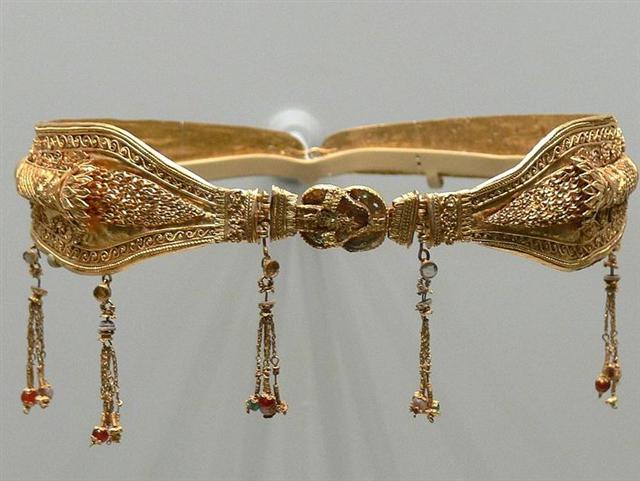|
3. We can then insert γ Coma Berenicis in its proper place in the G text, viz. together with Acrux:
What is the 'Candelabra' (Crux) if not a kind of trident? "Although it is not easy for the casual observer to locate any of the individual stars except the lucida, three have been lettered - α, β, and γ that Baily claimed for Flamsteed's 7, 15, and 23. Of these Fl. 15, an orange star, is generally supposed to be the Arabian Al Dafirah [The Braid], from Ulug Beg's name for the whole that he located among the informes of Leo." (Allen) Diadem and Al Dafirah are rising close together:
"A diadem is a type of crown, specifically an ornamental headband worn by Eastern monarchs and others as a badge of royalty. The word derives from the Greek διάδημα diádēma, 'band' or 'fillet', from διαδέω diadéō, 'I bind round', or 'I fasten'. The term originally referred to the embroidered white silk ribbon, ending in a knot and two fringed strips often draped over the shoulders, that surrounded the head of the king to denote his authority. Such ribbons were also used to crown victorious athletes in important sports games in antiquity. It was later applied to a metal crown, generally in a circular or 'fillet' shape. For example, the crown worn by the kings of Anglo-Saxon England was a diadem, as was that of a baron later (in some countries surmounted by three globes). The ancient Celts were believed to have used a thin, semioval gold plate called a mind (Old Irish) as a diadem. A diadem is also a jewelled ornament in the shape of a half crown, worn by women and placed over the forehead (in this sense, also called tiara). In some societies, it may be a wreath worn around the head. The ancient Persians wore a high and erect royal tiara encircled with a diadem. By extension, 'diadem' can be used generally for an emblem of regal power or dignity. The head regalia worn by Roman Emperors, from the time of Diocletian onwards, is described as a diadem in the original sources. It was this object that the Foederatus general Odoacer returned to Emperor Zeno (the Emperor of the Eastern Roman Empire) after his expulsion of the usurper Romulus Augustus from Rome in 476 CE." (Wikipedia)
(Gold diadem. Greek, probably made in Alexandria, Egypt, and belonging to a noblewoman of the Ptolemaic dynasty (220–100 BC): the clasp is shaped as a Herakles knot.) "The reef knot is used to tie the two ends of a single line together such that they will secure something, for example a bundle of objects, that is unlikely to move much. In addition to being used by sailors for reefing and furling sails, it is also one of the key knots of macramé textiles. The knot lies flat when made with cloth and has been used for tying bandages for millennia. As a binding knot it was known to the ancient Greeks as the Hercules knot (Herakleotikon hamma) and is still used extensively in medicine. In his Natural History, Pliny relates the belief that wounds heal more quickly when bound with a 'Hercules knot'. It has also been used since ancient times to tie belts and sashes." (Wikipedia) "The reef knot or square knot is an ancient and simple binding knot used to secure a rope or line around an object. Although the reef knot is often seen used for tying two ropes together, it is not recommended for this purpose due to potential instability of the knot. A reef knot is formed by tying a left-handed overhand knot and then a right-handed overhand knot, or vice versa. A common mnemonic for this procedure is 'right over left, left over right', which is often appended with the rhyming suffix '... makes a knot both tidy and tight'. Two consecutive overhands of the same handedness will make a granny knot. The working ends of the reef knot must emerge both at the top or both at the bottom, otherwise a thief knot results." (Wikipedia)
Right over left, left over right, makes me remember the star Newton (α Virginis), because Isaac Newton's personal coat of arms resembles the flag of the sea-born pirate (without the skull, though):
"I do not know what I may appear to the world, but to myself I seem to have been only like a boy playing on the sea-shore, and diverting myself in now and then finding a smoother pebble or a prettier shell than ordinary, whilst the great ocean of truth lay all undiscovered before me." (Wikipedia) Presumably 'bones' crossing each other was visualized in the hahe type of glyph
But there are no hahe signs in the G text. |
|||||||||||||||||||||||||||||||||||||||||||||||||||||||







